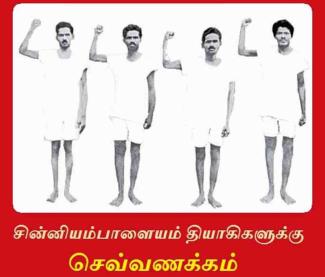In 1911, Ranga Vilas was a ginning factory. It was subsequently developed into a textile mill by 1922. In this process, Coimbatore became a hub of spinning and textile mills and emerged as and came to be known as the Manchester of South India. Thousands of men and women employed in textile mills were subjected to cruel exploitation. Workers had to work for 14 to 15 hours a day. Textile managements employed local rowdy elements as maistries (supervisors). They were adopting all kinds of medieval practices to earn super profits by denying workers heir dues. The four young workers called Ramaiyan, Rangannan, venkatachalam and chinnaiyan, were in the forefront of raising the voice of workers and in fighting for their rights. It was not to the liking of the repressive management.
Ponnan was one such maistry in Renga Vilas mill. He used to sexually harrass and exploit women workers. One woman worker, by name Raji, was not only bold enough to resist sexual harassment but also led women workers in their fight against economic and gender oppression.
In the year1940, at the dawn of the fateful day, Raji was walking alone after parting off from her co- workers. She was way laid by a gang of four who came in a horse cart. They forcefully pushed Raji into the cart with her hands tied. They also sealed her mouth with clothes to prevent her from raising any alarm. Then, she was taken to a secluded place where she was gang raped.
On hearing the incident, four angry young workers called Ramaiyan, Rangannan, venkatachalam and chinnaiyan of chinniampalayam rushed to the spot and thrashed the culprit Ponnan. He succumbed to injuries as a result of the people's anger, especially of women workers.
The mill management which was eagerly waiting for an opportune moment to take vengeance against the four young fighters of workers’ rights framed them under false charges including murder, in active collusion with the corrupt police. Singanallur police, under the limits of which the Chinniyampalayam village falls, implicated all four budding trade union activist under the charges of murder and put them behind the bars.
The solidarity and support from mass of workers historic and unprecedented. Whenever their case was coming up for trail, thousands of workers were gathering at the court premises to express their solidarity with their comrades in arms languishing in jail. The undivided communist party and their trade union also tried to save them. Popular leading lawyers were engaged to represent the jailed workers. Still, the lower court ordered to hang them. Even their appeal was taken upto the privy council in London. But, all efforts went in vain. On the other hand, the privy council ordered death penalty for all the four workers.
The Privy Council offered them a concession that three of them may be let off if one of them confessed the crime. But, all four fighters rejected the offer in unison. They informed the Privy Council that they would either live together or die together and would never confess the crime. The brave fighters exhibited such a commitment and determination to the cause and became leaders and martyrs of the textile workers movement. Their sacrifice will never be forgotten by the textile workers movement in the state.
Senior leaders of the communist party met the workers inside the prison after the final verdict. In fact, the leading comrades who went to met them were visibly shaken by the court order. On the contrary, the four workers, under whose head the noose was hanging, displayed such an exemplary courage and determination. They raised thunderous slogans of “Inquilab, Zindabad!” and “Lal Salam” that reverberated every nook and corner of the Coimbatore Central Prison, and, in turn, in the entire city of Coimbatore and in the entire textile workers movement of Tamil Nadu. All four brave fighters were hanged to death at the wee hours of 8th January 1946.
The entire city of Coimbatore and the textile workers mourned the death of the worker heroes. The city had never witnessed such an unprecedented large gathering of workers. Thousands and thousands of workers marched on the streets of Coimbatore carrying the bodies of their emancipators and fighter comrades. All four were buried together at the same place as per their last wish.
Even after sea changes in the socio, economic and political complexion of the city of Coimbatore and in the textile movement, the great sacrifice for a cause of the rights of workers and the movement by these four young comrades continue to be fondly remembered by everyone. The sacrifice of these young martyrs will continue to haunt the exploitative system until it is put an end.











